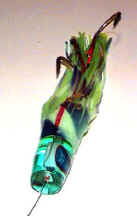Rigging Pakula Lures
by Peter Pakula
THE PAKULA SHACKLE RIG
The Shackle Rig was developed by Peter Pakula specifically for use with his Pakula Lures in 1984 and has remained the most successful rigging system since. The Shackle Rig has many assets: The lure has total freedom of action. The hookup rate has remained unsurpassed for over 12 years. The hooks self-align. You can change hooks quickly and only need several sets of hooks that can match up with many lures.

THE PAKULA FULL SHACKLE RIG
1- Leader: The thinner the leader the better the action of the lure and as with all fishing, the lighter the leader the more fish will be fooled. (The maximum recommended leader size is listed with each lure in the lure reference pages).
 2- Rubber Washer: This washer protects the leader from fatigue and abrasion against the back of the lure head.
2- Rubber Washer: This washer protects the leader from fatigue and abrasion against the back of the lure head.
3- Crimp: When crimping nylon ensure you leave the ends of the crimp flared so the edges do not cut the leader. When using wire the full length of the crimp should be crimped. Make sure the crimps are the correct type and size for the nylon you are using.
4- Thimble: The stainless thimble allows the shackle to swing freely. These have a gap when purchased which must be closed prior to inserting snugly in the leader loop, as under pressure they may twist and sever the leader.
5- Shackle: The shackle should be small enough to allow the hooks to swing and align.
6- Stainless Wire: Use stainless 7 x 7 which is semi ridged so that it lies straight and protects the rig against ‘toothy critters’. The 60 degree set up of the hooks is done by twisting the wire to align the hooks.
7- Loose Collar: By using a loose collar the hooks are free to swing and move with the lures action without retarding it. The collar also restricts the wire from crossing over the hook and fouling.
8- Top Hook: The top hook and trailing hook should be the same size to balance the rig. We prefer hooks that have turned in points such as the Southern Tuna Style as statistics have shown these to have a much higher success rate than hooks with a straight point. (The recommended hook sizes are listed with each lure in the lure reference pages).
9- Shrink Tubing: On the wire and hook the tubing only covers half the loop so the hook remains free to swing, yet prevents the hooks from swinging all the way around and hanging up on the lure head or other hooks.
10- Trailing Hook: This hook should be set back in the lure skirt so that at least the point is below the skirt. In areas of ‘toothy critters’ to minimise skirt damage set the hook right back so that only the eye is within the skirt. This hook and wire should be set at 60 degrees to the forward hook forming a “V”. The positioning of the hooks in the lure determines which way up the lure will run as the hooks at this angle will both ride point up when trolled. Both hooks will ride with their points riding up. Normally you would wish to run the lures so the dark side is uppermost. To accomplish this place both hook points in the dark side of the skirt. There is no need to fix the hooks in position as the drag on the skirt will prevent them from moving. Great care should be exercised with these rigs especially if they are in a fish you're handling. The effectiveness of the Pakula Shackle Rig can be shown by how many anglers and crew become “attached” to them.
TAKE GREAT CARE WHEN HANDLING TWIN HOOK RIGS!





